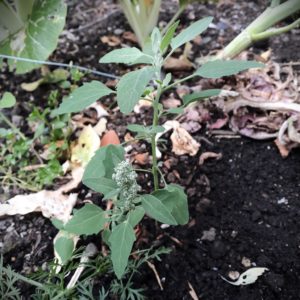When I first learned about this edible weed, I knew I had seen it around town. But I just couldn’t find it. Months went by, no sign of it.
Then in mid-August, I looked under the leaves of my bolted bok choy in the garden. There were three tiny lambsquarters! Since then, several more have sprouted up around my yard, between the garden pavers and next to my cultivated plants.
Lambsquarters are in the same family, Amaranthaceae, as amaranth and spinach, and the same genus, Chenopodium, as quinoa! The leaves are edible and have an extremely mild green taste, which some say is similar to spinach. (I didn’t think it tasted like much at all. Not bad, for sure, but not notably delicious either.)
In addition to the leaves, lambsquarter seeds are edible like quinoa! (However, the seeds are tiny compared to quinoa, and challenging to separate from the plant matter.)
I’ve seen multiple sources cite toxicity concerns with this plant (oxalates and saponins). On the other hand, multiple sources say it’s all perfectly safe to eat. So what are we to believe?

Also known as: lamb’s quarters
Species: Chenopodium album is called common lambsquarters, but there are numerous Chenopodium species that people refer to by that name. C. berlandieri (pitseed goosefoot) is one such example, also common in North America.
Origin: Chenopodium album comes from Europe. C. berlandieri is indigenous to North America. C. quinoa comes from the Andean mountain region of South America.
Why Do Some Sources Say Lambsquarters Are Dangerous?
I have read several articles that claim that lambsquarters contain toxic chemicals and that you should be cautious about consuming them. Specifically, they caution about the saponins in the seeds and the oxalic acid/oxalate in the leaves of lambsquarters. Such articles note that saponins could be “toxic” and general consumers may be advised to go easy on foods containing oxalic acid.
The Wikipedia article on Chenopodium nuttailliae (called huauzontle in Mexico) says, absent citation:
Like quinoa, another plant in the genus Chenopodium, huauzontle contains saponins, albeit in lesser quantities. While saponins are toxic to humans, huauzontle contains such small amounts that they pose no risk. Additionally, saponins are difficult for the human body to absorb, and are mostly rendered inactive when cooked.
I don’t have any reason to disbelieve that saponins and oxalic acid are present in lambsquarters and they could be bad for some people or in high quantities. However, nobody is getting down to the kind of specifics I want to hear:
How much saponins would it take to have an adverse effect and how much is in a normal serving of quinoa or lambsquarters seeds?
Are oxalic acids bad for everyone in any quantity? (I haven’t read any source yet saying this. Oxalic acids are present in some kidney stones, and some doctors advise people with kidney stones to avoid foods containing them. Scientists first isolated them from oxalis plants, and if you’re interested, I’ve written more about a couple of our local oxalis species, common yellow wood sorrel and creeping yellow wood sorrel.)
Simply having any quantity in a food isn’t enough to claim danger. Lots of things are bad for you if you have enough of it – for example, water! Water is bad for you if you drink a gallon of it all at once. But water is very good for you when consumed regularly throughout the day and to prevent dehydration.

Can I eat lambsquarters?
A good rule of thumb when it comes to edible plants is to eat a small amount when you first try it. Also, don’t try a bunch of new plants all at the same time, or even the same day. (If you did have an adverse reaction you wouldn’t have any way of knowing which plant caused it!)
If you know that you are extremely sensitive to oxalates/oxalic acid or saponins, or if a medical professional told you to avoid spinach or quinoa (or if you don’t feel well when eating them), then maybe lambsquarters isn’t for you.
This seems like another case of information being passed around like a really paranoid game of Telephone, where someone tells you “Lambsquarters have detectable amounts of oxalic acid and saponins but not in huge amounts that are a concern for most people” and it eventually becomes “Lambsquarters has CHEMICALS that could HURT you, OMG.”
I am not a nutritionist or scientist but I see a lot of people in plants repeating the same information that we all copied from each other or the same book or whatever. As far as I can tell, for the vast majority of people, you don’t need to be concerned about eating lambsquarters as part of your regular food intake.
Usage
Lambsquarters leaves are quite delicate and wilt extremely quickly after picking. Be prepared to use them right away. Try them cooked as a substitute or supplement for spinach, or as a little snack. So far, I’ve basically just been snacking on them when I see them.
One of the best things about foraging is the ability to just snack on a ton of different plants. I’m always hearing how eating a wide variety of plants is good for you!
Identification Notes
- likely to be found on disturbed bare soils like your backyard garden, city parks, or on farmland
- lambsquarters, including both C. album and C. berlandieri, have:
- delicate, alternating light green leaves up to a couple inches long
- white dusty coating on one or both sides of the leaves
- highly variable leaf shapes, ranging from ovals to toothed leaves
- tight clusters of flowers/seeds at the top of the stem
- C. berlandieri (pitseed goosefoot) has “pits” on the seed/fruit which are quite difficult to see with the naked eye. Check out the GoBotany Native Plant Trust links below for closeups. I’ve mostly been assuming I’m seeing C. album because it seems to be more widespread/invasive.
